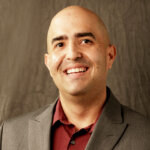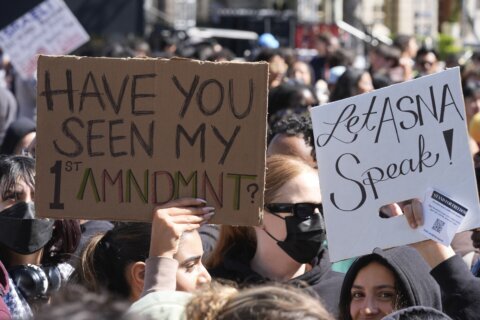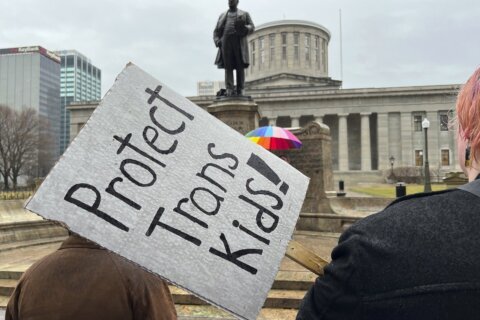For students, there are a lot of things that go into choosing community college, from a desire to pay less in tuition to the need to have more flexibility when balancing work, family and school.
But during COVID-19 students have found themselves with a lot more on their plates.
“There were a million things going on,” said Abdi Nur, 29, who tried to restart his college education at Northern Virginia Community College shortly after the pandemic began.
He said with family moving back into the house and needing to work from home, to him catching COVID-19 three times, he had to make the decision to withdraw.
He re-enrolled in January of this year, but said he may have considered coming back sooner if more in-person options remained available, including places for students to come to study away from home.
“There was definitely not a lot of that during COVID,” the information technology major said.
For Dana Parker, who attended the same college, she said changes during the pandemic actually helped her get to the finish line on 2020.
“I found it easier to be online,” Parker said.
One reason, according to Parker, is that advising was no longer mandatory. She said she went through several advisers during her time at the college, which made the process confusing.
“Having a multitude of advisers, I ended up getting set back a year, just through taking courses that maybe don’t transfer or just don’t count,” Parker said.
When asked about the decline in enrollment seen at NOVA and other community colleges, she said in addition to improving the advising process, she believed her college can make some additional changes to attract more students.
“I think if they get really specific on what you can do there, and the goals that you can achieve, and maybe even some staff highlights, because truly, I had some of the most influential professors ever, at NOVA,” Parker said.
Some area colleges in the D.C. region do have well known professors, including NOVA, where first lady Jill Biden is a professor in the English department.
Parker said she believed more messaging from schools should also tackle the stigma that can surround community colleges.
“This is a place to experiment, and just really getting out all the things that you can truly do at community college rather than just looking at it as like a second choice,” Parker said.
Nur is restarting his college career after withdrawing earlier in life from Wake Forest University. Speaking to fewer students enrolling, he said it’s unfortunate that there aren’t as many students jumping at the opportunity to go to community colleges.
“I’m enjoying it and taking full advantage of it, and it is a shame that rates are declining,” Nur said.
He said he believed one contributing factor could be older potential students hitting a hurdle he had to overcome before enrolling as well.
“Maybe more of like, a mental hurdle in the sense of, you kind of don’t feel as much as a traditional student just because of maybe your age or something,” Nur said.
How schools are trying to tackle the decline in enrollment
Tyson Beale, the vice president for student affairs at Prince George’s Community College, said the school is focusing on adapting to the changes in how students want to learn as the pandemic wanes.
“We have a lot of students that are more interested now in attending classes virtually and in an online capacity as opposed to face to face,” Beale said.
Beale said currently 68% of students still want to learn virtually, with 4% looking for a hybrid option.
As the college looks at expanding its virtual options, it is looking to bring in more students who are being lured in by certificate-only programs too — by creating more offerings that would attract them.
“So we are providing students with greater opportunities for certification and credentialing,” said Clay Railey, executive vice president and provost of teaching, learning and student success at Prince George’s Community College.
The financial aspect cannot be overlooked either. Both Beale and Railey said in response to financial hardships seen by students, the college is reaching out to those who might be willing to come back to class with some financial help.
“I know we’re providing some incentives, kind of like ‘buy one, get one free’,” Railey said. “So sign up for a course, we can subsidize another course, if you take a second one.”
Beale said millions of dollars from the Higher Education Emergency Relief Fund, which was part of the federal government’s CARES Act, is helping the school and others bring back students who paused their education because of COVID-19 as well.
Railey said some of the efforts are already showing results, with summer enrollment numbers currently up for 2022.
Jermaine F. Williams, president of Montgomery College, said one thing his school is doing is expanding partnerships with Montgomery County Public Schools and the Universities at Shady Grove in North Potomac.
“So students have this seamless transition to Universities at Shady Grove, which is a really good unique opportunity that has nine state institutions at one local Montgomery County-located physical facility,” Williams said.
Williams said working with public schools bolsters dual enrollment opportunities for high school students, allowing some to graduate from high school with an associate degree.
He said while listening to students concerns it became apparent that more options for shorter courses were needed too. That led to both seven-week and 13-week programs.
“So they are still able to earn money, they are still able to pursue their education,” Williams said.
In an effort to address financial difficulties facing many students, the school is developing more courses in which textbooks are not required.
Michelle Brown-Nevers, vice president for enrollment management and student success at Northern Virginia Community College, said the school is looking at more certificate programs too.
Plus, Northern Virginia Community College is trying to attract more adults who are outside the typical college student age range of 18 to 24, who didn’t go to college when they were younger but would like to now.
“When you’re working, and you’re going to a four-year institution, and you’re going part time, it may feel like a longer time away than working on getting that associate degree,” Brown-Nevers said.
This comes as school leaders noticed a decline in birthrates had led to fewer college-aged students.
Some Northern Virginia Community College students are attending both the community college and George Mason University at the same time with the school’s advanced program.
“They have that pathway to get their baccalaureate degree, while getting their associate degree with us first. And it also saves them a great deal of money where they don’t pay the full year price for four years, they pay with us first, and then transition over,” Brown-Nevers said.
As enrollment declines: ‘Can we change that trajectory? Yes, we can’
When it comes to colleges in Maryland, despite a decline in enrollment, Brad Phillips, executive director for the Maryland Association of Community Colleges, said community colleges in the state are educating more residents than any other higher education option.
“I think we still have a very vital role to play in our local and regional workforce needs in our economy here in the state,” Phillips said.
He said the goal in the state is to have 40% of students graduating from high school with some type of licensure and certification.
Williams said you’ll see more work while you learn options down the road.
“It really speaks to putting students in those positions, that they are engaged in the profession of which they’re pursuing, while they’re in their community college setting,” he said.
Railey said while the pandemic brought some difficult times to colleges, he said it showed how essential community colleges are for providing access to higher education too, as they provide more accessible and affordable educational opportunities to a very diverse population.
“I think that the last couple of years has really dramatized how important and essential community colleges are to addressing all sorts of equity and inclusion issues,” Railey said.
Sharon Morrissey, senior vice chancellor for academic and workforce programs for the Virginia Community College System, said that you should plan to see more of those types of programs in the state.
That would include a single location in Virginia that would provide shorter-term training in high demand fields.
“Think of areas like construction trades, people who build roads, who build bridges, who build tunnels,” Morrissey said.
“Think of energy production, people who work on solar energy or you know, other wind energy alternative energy sources. In particular, think about IT professionals, people who need to get certifications for advancement in IT fields,” she continued.
Looking to the future, Morrissey said she believes community colleges can turn the declining enrollment numbers around.
“Can we change that trajectory? Yes, we can.”








